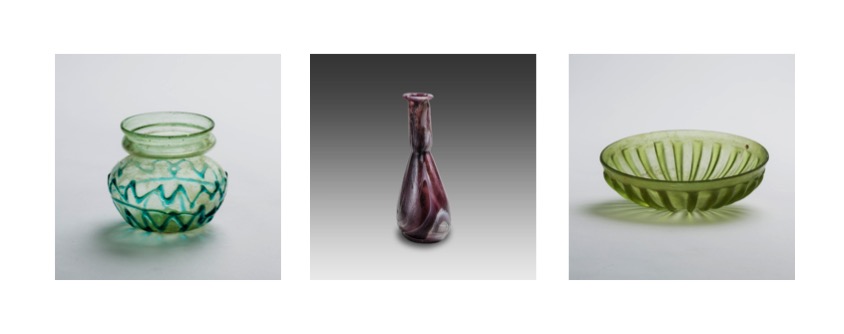
Glass, a luxury and exquisite material, whose technical virtuosity reached a peak during ancient times. Both a natural element tamed by man to match the finest precious stones, and an element of fascination modeled to suit human taste, in playing with the effects of colors and the natural light reflections.
Nowadays, glass is still a magical material, especially since, among the witnesses of humanity’s glorious past, it seems timeless and surprisingly contemporary to the modern eye.
Glassware Production in the Antiquity
The earliest known glass objects were beads, which appeared in Mesopotamia in the middle of the 3rd millennium B.C. A thousand years later, the first elaborate glass containers (amphoriskoi, aryballoi…), were introduced in Mesopotamia and Egypt.
Core-formed glass vessels were produced in the Eastern Mediterranean area from the late 6th century B.C. already.
Slightly later, mosaic glass (also known – although incorrectly – as millefiori glass) emerged in Egypt.
Glass Production Process in the Hellenistic period
During the Hellenistic period, Alexandria was the major center of glass production and ahead of most other cities in the development of new techniques.
Glass blowing is thought to have been invented by the Phoenicians or the Babylonians. With the aid of the blowpipe, a great variety of glass objects were produced more easily, more quickly and therefore cheaply. This revolutionary step occurred in the third quarter of the 1st century B.C.
Imported from the Eastern Mediterranean region (Egypt and Syria), glass in a primary form was transported by boat all across the Mediterranean basin, where it was recast into new shapes.
The Romans expanded and developed the range of available shapes, both for drinking vessels and for storage or serving containers. They created a richer and more elaborate decorative style by using the technique of mold-blown glass (heated glass blown into molds), and by applying threads and other colored or non-colored adornments on the surface of the glass. Engraving, gilding or cameo carving were also used.
Virginie Sélitrenny
“Objects of the Month”, selected by the Young Collectors Gallery, come meet us and discover – or rediscover – the richness and beauty of ancient vessels.
Suggested reading on the topic, including a richly illustrated history of glassmaking: DILLY G. and MAHEO N., Verreries antiques du Musée de Picardie, Amiens, 1997.

